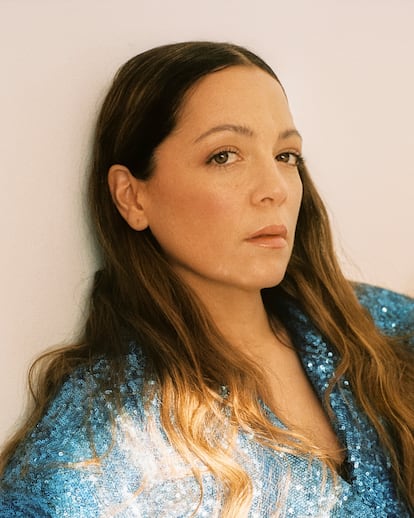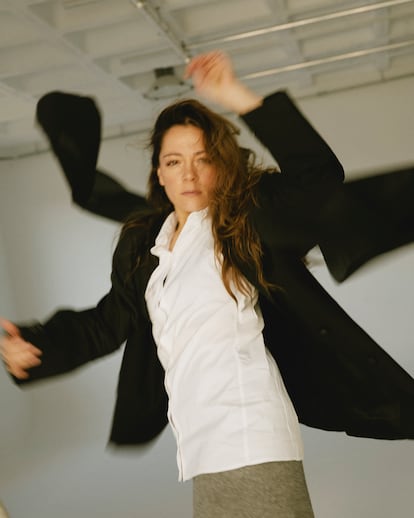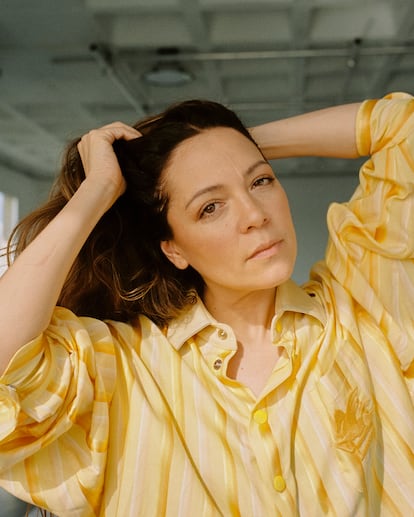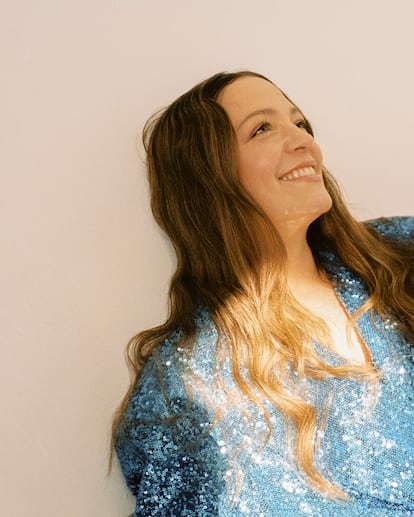Natalia Lafourcade, Mexican singer: ‘Reggaeton must have something that I just don’t understand’
One of the most fascinating and successful Latin American folk performers, Lafourcade reached a point in her career where she needed to stop and take a breather. To find herself, she returned to the garden of her childhood home in Veracruz, along the Gulf of Mexico

That guava tree in their garden wasn’t just an ordinary tree. Natalia Lafourcade’s parents had just split up and her mother needed money urgently. Then, that tropical tree — with its simple, oval leaves — began to bear unusual fruits. “We had little money and the tree kept us going. Every summer, there were enormous quantities of guavas growing… We had to lay out a net to catch them all. Then, my mom made jam, cakes and sweets out of the fruit. And we sold them,” recalls Lafourcade, 39.
Back then, the now-famous singer — who was born in Mexico City — was a two-year-old girl who felt a magical connection with that tree. “It taught me a life lesson: we need to pay respect to the land.” The guava tree was in the garden that belonged to her mother, Carmen, who inherited the family home in Veracruz, along the Gulf of Mexico. Lafourcade spent her childhood there, surrounded by flowers. Today, three decades later, she has returned to live in this property, where nature showed her all its love and gave her family a second chance. Hence the title of his latest album: De todas las flores [Of all the flowers].
“When I decided to record it, I felt that it was time to return to this inner garden, to my musical world. I wanted to recover my own language,” the Mexican composer explains. She is one of the most successful Latin American folk singers of this century, having won three Grammys and 15 Latin Grammys. With a career that has only lasted a little over a decade, Lafourcade set an international standard, admired by musicians from all walks of life.

In the house in Veracruz — which stirs so many feelings for her — Lafourcade composed many of her latest songs. “As soon as dawn breaks, I’m already surrounded by trees and birds. At all times, nature is giving me a concert. The rain is wonderful. The air smells clean. You feel like going for long walks and taking bike rides,” she says with a sigh. Lafourcade listened to this natural concert more carefully than ever during the pandemic, when she was confined to the land of her childhood. She has now decided to return to her roots.
“There was a stage in my career during which I knew that I had to start my engines, not stop them. I had to push to get things. But that fast pace became too much for me. I started to feel like I was on automatic pilot,” she recalls. “In the middle of all that, I was separated from my partner for a while. There was a lot of sadness… I had to let myself hit bottom,” she says, gesturing with her hands to show herself sinking into an imaginary hole.
“I had spent my whole life without any alone time. The pandemic [made me stop]... It gave me time. At first, I didn’t know how to relate to [such a different] lifestyle. I had to explore and find that part of me. When you hit rock bottom, you start building the process of going back up again.”
She remembers the moment in which she began to overcome this existential crisis, after getting back together with her partner and travelling to Veracruz. “Spring had arrived.”
Lafourcade’s spring is reflected in her new musical work. She talks about the album as if it’s a journey. “It makes the listener emerge feeling different,” she explains. It has influences from cumbia, bossa nova, folklore, Mexican ranchera, popular Peruvian songs… “There are no direct references, but a Simón Díaz, a Violeta Parra, a Roberto Cantoral, an Elis Regina can pass through there,” she laughs. And there’s something more local, from the land to which she has returned, the land that saw her grow up. “The air of Veracruz. This air, to me, is like the freedom and spiritual madness of a record like John Coltrane’s A Love Supreme. I wanted to transfer that trance into my album.”
The composer is deeply interested in Mexican sounds, but also appreciates tunes that are from farther away. “There’s a lot to study and explore. You just have to look at Spain, with its flamenco and folklore. There is so much! [Spanish music] has a peasant influence. When I hear it, it makes me want to learn more. And when you study music, you feel that your personal world is getting richer,” she says. And adds: “The song tells you where to go. The song dictates the way.”
Her path has a direct connection to her childhood — to that remote time of contemplation of nature. Her songs see her revise Mexican folklore in a contemporary style, in albums such as Mujer divina [Divine Woman] (2012), Hasta la raíz [To the Root] (2015), Musas [Muses] (2015) or Un canto por México [A Song for Mexico] (2020).
“Composing songs synthesizes my impressions of life; it’s an outlet,” she says. “My friend and collaborator David Aguilar told me that it was important to capture this early stage of my life, because it was honest and pure. Because it was me.”

Lafourcade’s first musical steps go back to when she was very little. She was 10-years-old when she went on stage for the first time. Her father, Gastón, came from the world of classical music and her mother was very fond of three artists in particular: Armando Manzanero, Violeta Parra and Mercedes Sosa, from Mexico, Chile and Argentina respectively.
“However, when I heard rancheras [Mexican country music], I really liked it. I started singing it at school. I sang [songs by] Juan Gabriel and José Alfredo Giménez,” she recalls. Her passion for singing was so great that she convinced her mother to take her to bars, where she could go on stage to perform her rancheras.
“My mom was a little scared of taking me [to those places], but she supported me. She bought me a pink dress, combed my hair and put some flowers on me.” Young Lafourcade sang every Saturday and there was no night that she didn’t enjoy it.
However, she didn’t know that she lacked technique until, one fine day, in the bathroom of a pub, both Lafourcade and her mother were made aware of it: “A lady grabbed me in the bathroom. My mom was there, too. She told us: ‘If the girl continues to sing like this, she will lose her voice. She sings with her throat; she doesn’t know how [to use her chest and stomach] and, on top of that, her voice is changing. It’s going to break. She has to take singing lessons.’ The lady sang with a mariachi band. I’m very grateful to her.”
Lafourcade began a long search for teachers. “I had no idea what I wanted to do. My only musical reference was what I had seen on television. I knew that I wanted to sing and that I wanted to be on television, because that was what I saw.”
“I got into the school singing group, where we sang everything, songs by Alicia Villarreal, Mecano, Selena, or Luis Miguel.” Yet, nothing satisfied her. The young singer became obsessed with getting on TV. “I wanted to go directly to Televisa (a major channel). My parents didn’t want it… My father didn’t even want us to drink Coca-Cola! He was the total opposite of pop and commercial culture. But I was so stubborn that I called the station every week to get them to give me a chance. My mother, after seeing the phone bill, realized that I was serious. She put me in a good music school. In the afternoons, I went to dance and acting classes. I started to learn more.” At the age of 15, Lafourcade joined a choreographic pop group that she prefers not to remember. “That was a horrible time,” she laughs.

She made her musical debut at the age of 18, with an album that bore her name: Natalia Lafourcade (2002). There’s an introduction in which she sings in English and sounds more like a jazzy singer, somewhat retro. Then, a special voice emerges — one that was eagerly applying itself to Mexican alternative pop. She was an artist in search of an identity.
By the time she released works such as Hu hu hu (2009) and Mujer divina [Divine Woman] (2012) — a tribute to Agustín Lara — Lafourcade had already achieved success in Mexico. She became a star. More importantly, many music lovers saw a singer-songwriter who was here to stay. And then came Hasta la raíz (2015), a huge hit, which created a mini-revolution in Latin American music. She won four Latin Grammys, as well as a Grammy for best alternative album — a milestone before the powerful American industry. As Julieta Venegas had done before, Lafourcade set a new standard. With an honest and deep voice, she managed to combine the worlds of folklore and pop, as if they flowed in a single stream. Since then, her goal has always been to be free, like those birds that fly over her garden in Veracruz.
“I feel like an outcast. Out of place. Sometimes, I don’t see how I fit into the times that we live in,” she confesses. She represents an alternative path to the reggaeton and urban music that dominates Latin America. Her path has a distinct personality, where the basic sounds are combined with pop, jazz and bolero. “I do this because [the sounds] attract me. They remind me of a more romantic way of living, with greater contemplation.” Her delicate, dreamy and evocative songs draw wonderful threads from the past to the present. Everyone can find different meanings in her songs, depending on what they’re thinking or how they’re feeling.
“Reggaeton is a reflection of our current culture. Millions of people connect with this kind of music. It must have something that I just don’t understand. There’s a language, an era, whether it’s right or wrong, I can’t say for certain. It’s not up to me to decide. I respect [different genres of music] a lot. I just know that, if I [joined that trend], everyone would look at me strangely. People who know me know that I’m always going against the tide; although, now, the tide and I are going together.”

The currents have led her to De todas las flores, an album that hides one of the most painful compositions in the life of its author. The song Muerte [Death] is dedicated to her nephew, Nicolás, who died at the age of 38 in the mountains. “He died in his space. He loved nature. He left a letter written in which he said that the only thing he would give up his life for would be the land,” she says. The song came to her in a “very brutal” way. “I feel like he needed me to do this song, to give it to his mom and sing it to her. I didn’t write the song. He did it, he dictated it to me,” she explains.
Nature is always present in her life, like the flowers that are laid out on Day of the Dead in Mexico. Flowers with strong scents and many petals, adorning the altars. “Marigolds are my favorites. Also the bougainvilleas, which are very warlike, or the orchids, which are exotic, very feminine, erotic. In Mexico, we call orchids volcano flowers.”
All these colors represent hope and can be found in the Veracruz garden where Natalia Lafourcade now spends her days. “There’s nothing better than knowing that this garden will always be there for me, because it’s mine.” And adds: “Life doesn’t go flat. There are always changes and movements. Everything is transforming, little by little, like flowers.”
Production credits
Sign up for our weekly newsletter to get more English-language news coverage from EL PAÍS USA Edition
Tu suscripción se está usando en otro dispositivo
¿Quieres añadir otro usuario a tu suscripción?
Si continúas leyendo en este dispositivo, no se podrá leer en el otro.
FlechaTu suscripción se está usando en otro dispositivo y solo puedes acceder a EL PAÍS desde un dispositivo a la vez.
Si quieres compartir tu cuenta, cambia tu suscripción a la modalidad Premium, así podrás añadir otro usuario. Cada uno accederá con su propia cuenta de email, lo que os permitirá personalizar vuestra experiencia en EL PAÍS.
¿Tienes una suscripción de empresa? Accede aquí para contratar más cuentas.
En el caso de no saber quién está usando tu cuenta, te recomendamos cambiar tu contraseña aquí.
Si decides continuar compartiendo tu cuenta, este mensaje se mostrará en tu dispositivo y en el de la otra persona que está usando tu cuenta de forma indefinida, afectando a tu experiencia de lectura. Puedes consultar aquí los términos y condiciones de la suscripción digital.
More information
Archived In
Últimas noticias
There is as much life left to discover on planet Earth as that which is already known
Dozens presumed dead, around 100 injured in fire at Swiss Alps bar during New Year’s celebration
Is porn for women different from conventional porn? We spoke to those who make it
Cartagena de Indias is sinking: What can the city do to mitigate it?
Most viewed
- David King, chemist: ‘There are scientists studying how to cool the planet; nobody should stop these experiments from happening’
- Reinhard Genzel, Nobel laureate in physics: ‘One-minute videos will never give you the truth’
- Oona Chaplin: ‘I told James Cameron that I was living in a treehouse and starting a permaculture project with a friend’
- Sinaloa Cartel war is taking its toll on Los Chapitos
- The Interoceanic Train, the Mexican alternative to the Panama Canal











































